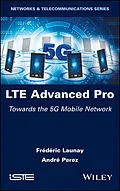This book presents LTE evolution towards 5G mobile communication and the emergence of new requirements for MBB, MTC and LLC services. As LTE technologies evolve, LTE Advanced Pro dramatically increases cell capacity and user data rates for the MBB unicast service. Such requirements are obtained using full-dimension MIMO, carrier aggregation (on either licensed or unlicensed frequency bands) and dual connectivity. To improve the efficiency of same-content delivery to multiple users, 3GPP proposes a group communications service over LTE and defines mission critical push-to-talk (MCPTT) for dedicated public safety services. Complementary low-cost and low-power modems with enhanced coverage and massive connectivity are emerging. Thus, this book also discusses the need for LTE to support low-rate transmission and high-latency communication for MTC services.
Inhalt
List of Abbreviations xi
Introduction xxix
Chapter 1. MBB Service Network Architecture 1
1.1. Initial architecture 1
1.1.1. Functional architecture 1
1.1.2. Protocol architecture 6
1.2. CUPS architecture 13
1.3. Heterogeneous networks 15
1.3.1. HeNB station 16
1.3.2. Relay node 19
1.3.3. RRH module 23
1.3.4. Dual connectivity 25
Chapter 2. MBB Service Spatial Multiplexing 29
2.1. Multiplexing techniques 29
2.1.1. MIMO mechanism 29
2.1.2. Beamforming 31
2.1.3. Antenna configurations 31
2.2. Antenna ports 33
2.2.1. Downlink 33
2.2.2. Uplink 35
2.3. UCI 36
2.4. Transmission modes 38
2.4.1. Downlink 38
2.4.2. Uplink 41
2.5. FD-MIMO mechanism 41
2.6. eFD-MIMO mechanism 46
Chapter 3. MBB Service Carrier Aggregation 49
3.1. Functional architecture 49
3.2. LTE aggregation 50
3.2.1. Radio channels 50
3.2.2. PDCCH physical channel 52
3.2.3. MAC layer 54
3.2.4. Mobile categories 54
3.3. LAA aggregation 57
3.3.1. Frame structure 57
3.3.2. Access to the radio channel 60
3.3.3. Discovery reference signal (DRS) 61
3.4. LWA aggregation 62
3.4.1. Protocol architecture 62
3.4.2. Procedures 63
3.5. LWIP aggregation 67
3.5.1. Protocol architecture 67
3.5.2. Tunnel establishment 69
Chapter 4. Wi-Fi Integration Network Architecture 71
4.1. Functional architecture 71
4.1.1. Architecture based on the S2a interface 71
4.1.2. Architecture based on the S2b interface 74
4.1.3. Architecture based on the S2c interface 76
4.2. Tunnel establishment 78
4.2.1. Architecture based on the S2a interface 78
4.2.2. Architecture based on the S2b interface 82
4.2.3. Architecture based on the S2c interface 83
4.3. DIAMETER protocol 84
4.3.1. AAA server interfaces 85
4.3.2. PCRF interfaces 89
Chapter 5. Wi-Fi Integration Procedures 91
5.1. Mutual authentication 91
5.1.1. EAP-AKA method 91
5.1.2. Mutual authentication procedure 92
5.1.3. Procedure for rapid renewal of authentication 95
5.1.4. Application to the MIPv4 FA mechanism 96
5.2. SWu tunnel establishment 97
5.2.1. IPSec mechanism 97
5.2.2. SWu tunnel establishment procedure 98
5.2.3. Procedure for rapid renewal of authentication 101
5.3. S2a/S2b tunnel establishment 102
5.3.1. PMIPv6 mechanism 102
5.3.2. GTPv2 mechanism 107
5.3.3. MIPv4 FA mechanism 109
5.4. S2c tunnel establishment 113
5.4.1. Trusted Wi-Fi access 114
5.4.2. Untrusted Wi-Fi access 115
Chapter 6. Wi-Fi Integration Network Discovery and Selection 117
6.1. Mechanisms defined by 3GPP organization 117
6.1.1. ANDSF function 117
6.1.2. RAN assistance 125
6.2. Mechanisms defined by IEEE and WFA organizations 125
6.2.1. Information elements provided by the beacon 127
6.2.2. Information elements provided by the ANQP server 128
Chapter 7. LLC Service Proximity Communications 133
7.1. Introduction 133
7.2. Functional architecture 135
7.2.1. D2D communication 135
7.2.2. V2X communication 139
7.3. Direct discovery 141
7.4. Radio interface 142
7.4.1. Radio interface structure 142
7.4.2. Physical resources 145
Chapter 8. LLC Service Group Communications 151
8.1. Introduction 151
8.2. Transport architecture 152
8.2.1. Functional architecture 152
8.2.2. ...
